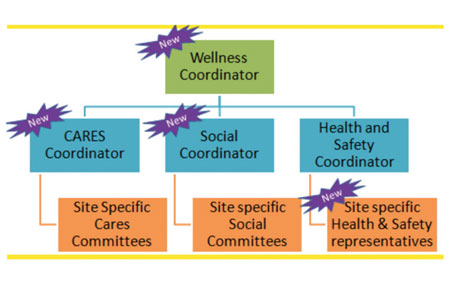
Back in Motion
|
bh IN BRIEF
Back in Motion Rehab Inc. (BiM) is a full-service rehabilitation and employment solutions company based in BC. For over 20 years, BiM has been helping people overcome barriers and reach their full employment potential. BiM delivers flexible, accessible interdisciplinary rehabilitation, disability management and employment services. With its committed, enthusiastic staff, BiM is known for creative solutions and exceptional results. BiM has received BC’s Psychologically Healthy Workplace Award (2009-2010) and is a multi-year winner of the Great Place to Work Institute™ Canada’s Great Workplace award (2006-2008).
Debbie Samsom, President, Back in Motion Rehab Inc.
|
Helping people work, helping people live.
“The key to our program – what makes it unique – is that it is run by staff. Everything that happens, happens at the grass roots level. Empowering staff in this way requires a high level of trust in people.”
Award-winning organizations know that intentional efforts to increase workplace wellness can make great places to work even better. Case in point: multiple award winning company, BC-based Back in Motion (BiM). Even though BiM had strong core values, a long track record and a great staff that provided health and employment services at 12 sites across the lower mainland, it felt something was missing. It understood that as a rapidly growing organization, its varied, independent activities were unlikely to support sustained workplace wellness in the future. To that end, BiM set itself a goal: to recognize and build upon existing informal workplace wellness activities and build a robust sustainable program for the future.
WHERE TO START?
First, BiM assessed its current approach and identified what was missing:
Second, with commitment from the organization, staff researched best practices; analysed internally what was working well, what wasn’t and what was missing; and developed a model that would provide a structure for their new wellness program and at the same time, focus on the grass roots. Focusing on the grass roots meant building a new structure on existing initiatives and – first and foremost – leaving most decision-making to staff at the various sites.
After settling on a model, BiM set about putting it into practice by creating job descriptions, identifying coordinators and getting volunteers at each site. After establishing a vision for each aspect of the initiative, BiM set budgets and launched its wellness program – via intranet and in-person.
BIM’S WELLNESS AT WORK MODEL
BiM’s workplace wellness model is based on a comprehensive understanding of wellness that includes five elements: Preventive, Physical, Psychological, Social and Lifestyle. Within the organization, these elements are addressed in four committee areas: Corporate Care (a group within HR responsible for BiM’s benefit plan and company-wide activities) and Health and Safety, Community Care, and Social Wellness (separate committees at each BiM site).
Figure 1: A new Wellness Coordinator in the HR department coordinates all initiatives throughout BiM. Volunteer staff at each site coordinate local committees in each specific area and are “point people” for cross-site initiatives. All staff belong to one of the three committees at their site.
Committee coordinators at each site (Figure 1) are accountable for setting and implementing their piece of the wellness vision, coordinating and planning goals and initiatives for their area of accountability, and measuring outcomes. They look after reporting and documentation and manage the yearly budget set by the Executive team.They also make wellness presentations to staff and the community.
Figure 2: The Wellness Program is a pyramid reflecting the relatively small participation of the executive at the top in relation to staff activities as the base broadens.
All staff members participate, with the greatest participation at the grass roots committee level (Figure 2). New hires are asked which committee they would like to join. Staff can stay with one committee or move to another as their interests change. The program structure is flexible and responsive to individual and community needs.
WHAT ARE THE COSTS?
The financial costs of the program are relatively modest since it relies on internal resources and grass roots volunteers. Even so, the efforts of coordinators and staff are recognized.Coordinators each receive a 5% salary top-up and up to $500 to attend or present at wellness courses or conferences. Everyone is allotted company time for volunteering and supporting wellness initiatives – including celebrating after events.
Overall, funding for the wellness program is determined on a “per staff member” basis. With a staff of 250, the current funding level is $220/person, but that is subject to change from year to year depending on changes in staff numbers or company policy.
WHAT ARE THE RESULTS?
Ultimately, BiM wants to achieve an integrated, comprehensive approach to wellness with deliverables and measures of success. With its new program in place, BiM has found that looking after the wellbeing of staff promises success on a number of fronts, including improved productivity and a healthier, happier workforce. Its goal is to create a culture of care for employees and the community and make a positive contribution to the community. Initial indicators are good. In 2012, while overall staff size doubled, staff turnover was only three people. In 2013 benefit plan costs are set to increase by only 5%, even as core values remain firm.
Why has the program generated so much enthusiasm and promise? What features contributed to its successful launch?
Here is a partial list:
WHAT IS THE BOTTOM LINE?
It is possible to make a great place to work, better. It is also possible to enhance a culture of wellness by intentionally adopting strategies and putting in place structures so that, together, employees and the organization can build and benefit from their own wellness initiatives.
|





